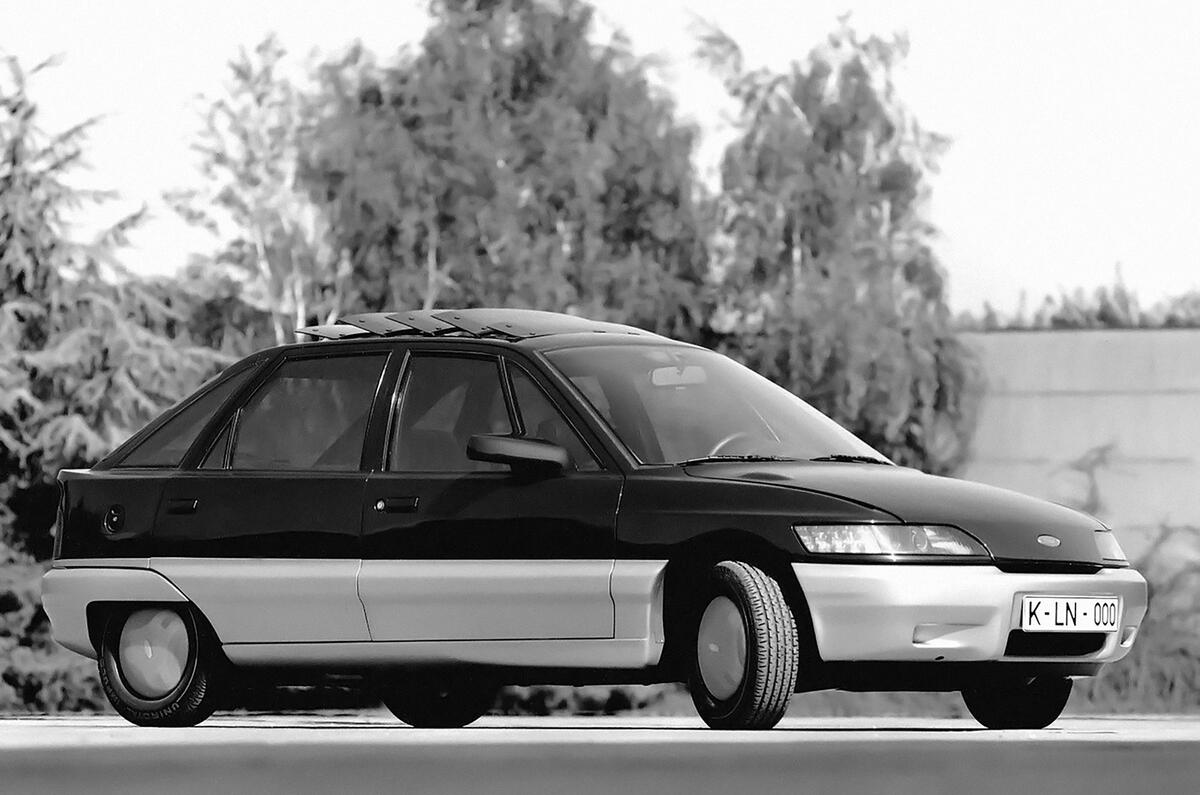During the 1980s Ford made a big effort to throw off its reputation for producing solid and reliable but hardly innovative cars and increase its focus on design and technology.
Out of that strategy came the Eltec, or ‘Electronic Technology’, an advanced prototype car that pointed to the way in which the company’s top designers and engineers perceived the car of the 1990s.The Eltec was a collaboration between Ford’s R&D departments in Dunton and Cologne, plus the Ghia Design Studio in Turin. It was made to “prove that even small family cars can benefit from electronic co-ordination of all their functions and that electronics can improve a car’s dynamics while reducing fuel economy and exhaust emissions”.
Built in less than 18 months for a Frankfurt show debut, the Eltec was bristling with ideas, as Autocar’s then technical editor Graham Jones described when he examined the car.“The body is a small, four-door hatchback configuration featuring a large glasshouse, a slippery shape and specially designed headlamps,” he wrote. “A glass sunroof comprised five louvres that could be either opened for ventilation or electrically retracted.
“The suspension is of the active ride variety, with its own electronic brain to control spring rates and ride height. The central black box also controls electronic anti-lock brake and anti-wheelspin systems, while the dedicated wheel/tyre combination is of the run-flat type.”The engine and its control system were the stand-out features, presaging today’s trend for frugal downsized units.
“The 1.3-litre unit is brand new and develops 80bhp at 5000rpm and 88lb ft between 2500 and 4000rpm,” wrote Jones. “Designed and built as part of Ford’s lean-burn engine technology programme, the aims were to produce a power unit with compact dimensions, low internal friction and the ability to pull well from low engine speeds at the same time as producing good performance through the speed range.
“The engine is mated to Ford’s CTX continuously variable transmission, using the familiar belt and pulley drive arrangement. Next to the gear lever is a smaller lever which allows the Eltec driver to select either ‘Power’ or ‘Economy’ modes. In the latter, the transmission ratio is controlled so that engine speed is at its most efficient.
“What makes these developments significant is that they are integrated using a modified version of the EEC-IV computer fitted to the 2.0 EFi Granada and Sierra. Unlike conventional cars with onboard computers, which control the engine and transmission as separate entities, in the Eltec the computer regards them as one system.
“The computer not only matches the operation of the engine and CVT to the demands of the throttle pedal but also continuously fine-tunes the engine to provide the best possible fuel consumption. In short, Eltec could herald the age when an engine holds perfect tune permanently.”
While Ford’s top brass emphasised that the Eltec didn’t preview a specific production model, Autocar’s man wasn’t altogether convinced, and noted that “a brand-new Escort is due in 1991”.
Previous Throwback Thursdays
4 March 1899 - Steam, electric or combustion engine?
26 June 1906 - The first French Grand Prix
9 July 1907 - The beginning of Brooklands
14 February 1913 - 100 miles in one hour
8 April 1916 - Making post-war predictions
25 March 1922 - Caterpillar tracks are the future
4 July 1925 - Citroën lights up the Eiffel Tower
2 February 1934 - The ethics of skidding
6 July 1934 - A tour of Cowley
1 June 1935 - Introduction of the driving test
22 June 1945 - Driving through post-WW2 Europe
21 January 1949 - Tidier tails
25 August 1950 - The evolution of transmissions
24 April 1959 - Aston Martin enters Formula 1
27 January 1961 - Ford Thunderbird road test
17 November 1961 - TVR Grantura road test
19 August 1966 - Four-wheel drive on test
6 May 1971 - Driving Ford's Supervan
12 June 1976 - Cars for under £100
10 July 1976 - Land's End to John O'Groats on one tank
13 May 1978 - Ferrari 512 BB road test
19 January 1980 - Talbot Horizon road test
13 February 1982 - 4x4s tested on the farm
17 April 1985 - Secrets of a lost British supercar
15 August 1990 - Giugiaro's vision of a 1990s Jaguar
28 April 1993 - BL's unseen concepts
16 March 1994 - Bentley's Concept Java
16 April 1997 - When Bugatti bit the dust
4 April 2001 - 0-260mph in 6.0 seconds
25 July 2001 - 180mph in a Chevrolet Corvette
Get the latest car news, reviews and galleries from Autocar direct to your inbox every week. Enter your email address below:




Join the debate
Add your comment
I recall very well all the
Rover beat it in group tests
Also on the 1990 Escort crime
Ha! Shame the 1990 Escort was
Some bad, some good
On launch, it was universally criticised by the press for roly-poly handling, understeer and poor engines. My 1998 version was sort of okay, even if the 1.6 was so weedy that putting the A/c on seemed to sap half its power. On the bright side, the hatchback Granada brought anti-lock brakes as standard to the masses, and was unique with its Triplex heated windscreen.